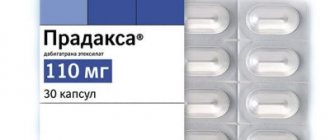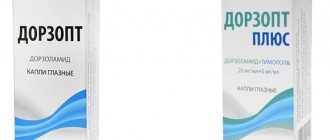Treatment for peptic ulcers varies depending on your medical history and individual symptoms.
According to modern medical protocols, treatment of a stable patient with a chronic ulcer is carried out with oral medications. But if hemorrhages develop, surgical intervention is prescribed. Numerous reviews of the drug Lancid Kit indicate that the medicine is quite often prescribed by gastroenterologists. Due to the fact that 3 different types of drugs are collected in one package, a comprehensive fight against H. Pylori is provided. The single drug Lancid, the main component of which is lansoprazole, is also available for purchase. The medicine can be used during an exacerbation of peptic ulcer disease.
Pharmacological properties Lancid
Lansoprazole blocks the enzyme H+-K+-ATPase, which is responsible for the entry of hydrogen ions into the parietal cells of the fundic glands. Due to this, the synthesis of HCl is inhibited at the final stage and the pH of the gastric environment increases. The active component improves the supply of oxygen to the mucous membrane and stimulates the secretion of bicarbonate, which protects the walls of the stomach from ulcerogenic factors and accelerates the healing of defects.
After doses of 15 and 30 mg, acidity decreases noticeably after 1-2 or 2-3 hours, respectively. The volume of HCl production, regardless of the nature of the stimulus, is reduced by 80-97%. The therapeutic effect increases within 4 days. After completion of therapy, acidity remains reduced by approximately 2 times relative to the normal level for almost 40 hours, and returns to its previous level only after 3-4 days. The drug does not cause rebound hypersecretion and does not affect the motility of the digestive tract.
note
Studies have shown that with a symptom complex caused by gastrin-producing tumors (Zollinger-Ellison syndrome), the effect is longer lasting.
The drug suppresses the growth of Helicobacter pylori colonies, as it promotes the production of specific immunoglobulins to the infectious agent. Due to the increase in pH, the anti-Helicobacter activity of antibacterial drugs increases.
Lansoprazole reduces the production of the main digestive enzyme pepsin. The substance helps well even with gastric and duodenal ulcers that are resistant to H2 receptor blockers. Up to 85% of duodenal ulcers heal within 4 weeks (at a dose of 30 mg/day). Its absorption occurs in the small intestine. Bioavailability is 80% and the highest plasma concentration is observed 1.7 hours after oral administration. Up to 99.4% of the total amount of the compound is conjugated with plasma albumin. In parietal cells, 2 active metabolites are formed. The biotransformation process occurs in the liver with the formation of inactive derivatives. They are excreted through the intestines (up to 2/3) and the kidneys.
Clarithromycin, included in the Lancid kit, belongs to the group of macrolides. The antibiotic and its main metabolite are characterized by bacteriostatic activity against Helicobacter.
Amoxicillin belongs to the semisynthetic antibacterial agents of the penicillin series. It blocks the synthesis of the main protein of bacterial cell walls, which leads to the death of microorganisms.
Both antibiotics are absorbed quickly and almost completely. The bioavailability of clarithromycin is 50%, and amoxicillin is up to 97%. Unchanged components and their metabolites are excreted in urine and bile.
Lancid Kit set of tabs/capsules (Micro Labs)
Before starting therapy, it is necessary to exclude the presence of a malignant process (especially with a stomach ulcer), since treatment, masking symptoms, can delay the correct diagnosis. Clarithromycin Long-term use of antibiotics can lead to the formation of colonies with an increased number of insensitive bacteria and fungi. In case of superinfection, appropriate therapy must be prescribed. Liver dysfunction (increased concentrations of liver enzymes in the blood plasma, hepatocellular and/or cholestatic hepatitis with or without jaundice) has been reported with the use of clarithromycin. Liver dysfunction can be severe but is usually reversible. There have been cases of fatal liver failure, mainly associated with the presence of serious concomitant diseases and/or concomitant use of other drugs. If signs and symptoms of hepatitis such as anorexia appear. jaundice, darkening of urine, abdominal tenderness on palpation, it is necessary to immediately stop clarithromycin therapy. In the presence of chronic liver diseases, regular monitoring of blood plasma enzymes is necessary. During treatment with almost all antibacterial agents, including clarithromycin, cases of pseudomembranous colitis have been described, the severity of which can vary mild to life-threatening. Antibacterial drugs can change the normal intestinal microflora, which can lead to the growth of Clostridium difficile. Pseudomembranous colitis caused by Clostridium difficile should be suspected in all patients who experience diarrhea after using antibacterial agents. After a course of antibiotic therapy, careful medical monitoring of the patient is necessary. Cases of the development of pseudomembranous colitis have been described 2 months after taking antibiotics. Clarithromycin should be used with caution in patients with coronary heart disease (CHD), severe heart failure, hypomagnesemia, severe bradycardia (less than 50 beats/min), as well as when used simultaneously with antiarrhythmic drugs drugs of class IA (quinidine, procainamide) and class III (dofetilide, amiodarone, sotalol). In these conditions and while taking clarithromycin with these drugs, you should regularly monitor the electrocardiogram for an increase in the QT interval. It is possible to develop cross-resistance to clarithromycin and other macrolide antibiotics, as well as lincomycin and clindamycin. In the event of acute hypersensitivity reactions, such as anaphylactic reaction, Stevens-Johnson syndrome, toxic epidermal necrolysis, drug rash with eosinophilia and systemic symptoms (DRESS syndrome), Henoch-Schönlein purpura, discontinue clarithromycin immediately and initiate appropriate therapy. Worsening of symptoms has been reported in patients taking clarithromycin myasthenia gravis. In case of combined use with warfarin or other indirect anticoagulants, it is necessary to monitor MHO and prothrombin time. Amoxicillin Before starting amoxicillin, it is necessary to collect a detailed history regarding previous hypersensitivity reactions to penicillins, cephalosporins or other allergens. Serious and sometimes fatal hypersensitivity reactions (anaphylactic reactions) to penicillins have been described. The risk of such reactions is highest in patients with a history of hypersensitivity reactions to penicillins. If allergic reactions occur, you must stop taking amoxicillin and start therapy with an antibiotic from a different group. In case of serious hypersensitivity reactions, appropriate measures should be taken immediately. Epinephrine administration, oxygen therapy, intravenous corticosteroids, and airway management, including intubation, may also be required. It is necessary to refrain from using amoxicillin if infectious mononucleosis is suspected, since in patients with this disease, amoxicillin can cause a morbilliform skin rash, making diagnosis difficult. Long-term treatment amoxicillin sometimes leads to excessive proliferation of insensitive microorganisms. During the use of amoxicillin, it is recommended to periodically evaluate renal, liver and hematopoietic function. Amoxicillin should be used with caution in patients with impaired liver function. Liver function should be monitored on a regular basis. In patients with impaired renal function, the dose of amoxicillin should be reduced according to the degree of impairment. Amoxicillin can provoke nonspecific binding of immunoglobulins and albumins to the red blood cell membrane, which can cause a false-positive reaction in the Coombs test. Crystalluria very rarely occurs in patients with reduced diuresis. When carrying out amoxicillin therapy, adequate fluid intake and maintaining sufficient diuresis are extremely important. In patients with cholangitis or cholecystitis, antibiotics can be prescribed only if the disease is mild and in the absence of cholestasis. During therapy with amoxicillin, it is necessary to remember the possible development of superinfection (usually caused by bacteria of the genus Pseudomonas spp. or fungi of the genus Candida). In this case, amoxicillin therapy should be discontinued and/or appropriate treatment should be prescribed. If severe diarrhea persists, antibiotic-induced pseudomembranous colitis, which may be life-threatening, should be suspected (watery stool mixed with blood and mucus; dull widespread or colicky abdominal pain; fever, sometimes tenesmus). In such cases, amoxicillin should be immediately discontinued and pathogen-specific treatment, such as vancomycin, should be prescribed. In this case, drugs that reduce gastrointestinal perilstatics are contraindicated. The excretion of amoxicillin leads to its high content in the urine, which can lead to false-positive results when determining glucose in urine (for example, Benedict's test, Fehling's test). In this case, it is recommended to use the glucose oxidase method for determining the concentration of glucose in the urine. If simultaneous use of amoxicillin with anticoagulants is necessary, prothrombin time or INR should be carefully monitored when prescribing or discontinuing amoxicillin. When using estrogen-containing oral contraceptives and amoxicillin simultaneously, other or additional methods should be used if possible contraception. Particular caution is recommended for patients with allergic diathesis or bronchial asthma, a history of gastrointestinal diseases (in particular, colitis caused by antibiotic treatment). When taking amoxicillin for a long time, nystatin, levorin or other antifungal drugs should be prescribed simultaneously. During treatment It is not recommended to drink alcohol. Lansoprazole It is recommended to avoid the combined use of proton pump inhibitors and clopidogrel. When used together, the risk of recurrent myocardial infarction, hospitalization for a heart attack or unstable angina, stroke, and repeated revascularization increases. If co-administration is absolutely necessary, patients should be closely monitored. It is recommended to avoid the combined use of proton pump inhibitors and antiretroviral drugs in HIV-infected patients. If combined use with atazanavir/ritonavir is necessary, it is recommended to maintain a 12-hour interval between taking lansoprazole and these drugs, and not to exceed the dose of lansoprazole 30 mg. When used together with antiretroviral drugs (indinavir, nelfinavir, atazanavir), as well as ketoconazole, itraconazole, posaconazole, cefpodoxime, cefuroxime and ampicillin, monitoring for their effectiveness and the emergence of resistance is necessary. Concomitant use with imatinib may increase the risk of adverse reactions (potential interaction via CYP3A4), especially in individuals with a history of severe allergic reactions. Due to the increased risk of myotoxicity, patients patients taking atorvastatin, lovastatin or simvastatin should be carefully monitored during concomitant use of lansoprazole. In patients taking concomitant warfarin, prothrombin time and MHO should be monitored. Long-term use of proton pump inhibitors increases the risk of infection (including Salmonella, Campylobacter, Clostridium difficile). The benefit of preventing bleeding from the upper gastrointestinal tract must be weighed against the potential risk of developing ventilator-associated pneumonia. Long-term use of proton pump inhibitors increases the risk of fractures in women during menopause. During treatment, alcohol should be avoided. Pharmacogenetic factor. The effectiveness of the drug depends on the genetic polymorphism of CYP2C19. In patients classified as “slow metabolizers” (RM-type), the effectiveness is higher; eradication of Helicobacter pylori is significantly more often achieved compared to “fast metabolizers” (homEM-type), even against the background of resistance to clarithromycin. “O syndrome if recommendations are followed.” the duration of use is not typical for lansoprazole. Effect on the ability to operate machinery and a car During the treatment period, care must be taken when driving vehicles and engaging in other potentially hazardous activities that require increased concentration and speed of psychomotor reactions, as the drug can cause weakness, drowsiness and dizziness .
Indications
Lancid is prescribed for the following diseases and pathological conditions:
erosion of the esophagus due to the backflow of acidic gastric contents;- GERD (gastroesophageal reflux disease);
- relapses of peptic ulcer of the stomach and duodenum;
- functional dyspepsia without organic gastrointestinal lesions;
- “stress” and “medicinal” ulcers;
- Zollinger-Ellison syndrome.
The Lancid kit kit is used to destroy Helicobacter pylori.
Contraindications
Drugs are contraindicated for diagnosed malignant tumors of the digestive tract. They are not prescribed to children and adolescents under 18 years of age due to lack of experience in use in pediatric practice.
note
A set containing 2 antibiotics cannot be used for porphyria, renal and liver failure, infectious mononucleosis and bronchial asthma.
Lancid and Lancid Kit are not prescribed to patients with intolerance to the active ingredients or auxiliary ingredients of the drug in order to avoid the development of allergic reactions.
Patient reviews of the drug Lancid
“I have been suffering from peptic ulcers for the past three years. Reflux and chest pain became my constant companions. The gastroenterologist who “guided” me in a regular district clinic advised me to go on a diet consisting of rice, apples, oatmeal, egg whites and a small amount of vegetables.
The diet certainly helped, but any deviation from it led to severe heartburn. And in general, the condition of the skin began to deteriorate (due to a lack of vitamins and minerals due to a poor diet).
As a result, I went to a private specialist and asked to be prescribed medications to relieve pain during periods of exacerbation. The doctor prescribed Lancid for me. I took the first course six months ago, and for almost 3 months I didn’t remember that I had an ulcer. When the negative symptoms began to appear again, I decided to take Lancid without going to the doctor. As a result, there was practically no effect. I’m thinking about trying some analogue with lansoprazole in the composition.”
Korolchuk Irina Petrovna, 42 years old
“I initially took Lancid as prescribed by a gastroenterologist due to diagnosed severe acid reflux. I took the pills for only 3 days and encountered side effects such as nausea, dry mouth and stomach pain. I decided to see another doctor, who ordered a test for H. Pylori.
After receiving a positive result, the gastroenterologist advised me to continue taking Lancid, but with the “Kit” prefix. It turned out that the package contained as many as 3 different types of tablets with different effects on the body. After such shock therapy, I developed other side effects in the form of severe hunger and drowsiness.
As a result, I gained about 5 kilograms while taking the medicine. Repeated tests showed that H. Pylori was not detected. But a week after completing the therapy, I again had a sour, unpleasant taste in my mouth. So I consider the tablets (both Lancid and Lancid Kit) to be ineffective in the treatment of acid reflux.”
Artyushkina Polina Romanovna, 30 years old
“At first I fully supported the few positive reviews about Lancid. Acid reflux and chest pain that accompanied the peptic ulcer disappeared almost immediately after the start of treatment. I needed to take the drug for about 18 weeks.
There were minor side effects during the process (digestion, dizziness, fatigue), but for me this was not a critical problem. Towards the end of the course, I began to experience severe yellow diarrhea and vomiting. Moreover, attacks of the disease could occur at night. In the end, I decided to end treatment with Lancid. After about 2 weeks, GERD relapsed, but the pharmacist advised me to buy Gaviscon).
After about 2-3 weeks I began to feel completely healthy. I think that my doctor incorrectly calculated the duration of taking the drug. A sick stomach simply couldn’t handle such a large amount of chemistry.”
Petrov Igor Konstantinovich, 38 years old
“I can say that the positive reviews from doctors about Lancid Kit are absolutely true.
I suffered from acid reflux for several months, and following folk remedies the condition only worsened. Severe heartburn occurred literally after every meal. After lengthy gastroenterological examinations, I was prescribed Lancid Kit. The price for the set was almost 900 rubles, but in the end I didn’t regret a penny. The heartburn went away after six weeks of therapy. The only side effect was diarrhea, which disappeared immediately after stopping treatment."
Zinoviev Alexey Dmitrievich, 45 years old
Dosages and regimen of Lancid and Lancid kit
For duodenal ulcers, lansoprazole is prescribed 30 mg once a day. It is advisable to take it in the morning on an empty stomach. The duration of the course is from 2 to 4 weeks, depending on the severity of clinical symptoms and the dynamics of the process. A similar treatment regimen is indicated for “stress” ulcers.
For esophageal erosions and gastric ulcers in the acute stage, the daily dose is from 30 to 60 mg at the discretion of the gastroenterologist, and the duration of treatment is from 4 to 8 weeks.
GERD requires 30 mg/day. for 4 weeks.
For Zollinger-Ellison syndrome, the dosage is selected purely individually; The criterion for effectiveness is a decrease in basal secretion below 10 mmol/h.
For functional dyspepsia, take 15-30 mg for 2-4 weeks.
For Helicobacter eradication, 30 mg twice a day is prescribed in parallel with two antibiotics for at least 1 week.
Triple therapy involves taking 1 capsule of lansoprazole, 2 capsules of amoxicillin and 1 tablet. clarithromycin twice a day (in the morning and evening before meals). It takes 1 to 2 weeks to destroy pathogenic microflora.
Lancid® Kit
Clarithromycin
When taking clarithromycin together and drugs that are primarily metabolized by CYP3A isoenzymes, a mutual increase in their concentrations is possible, which can enhance or prolong both therapeutic and side effects.
Contraindicated
combined use with astemizole, cisapride, pimozide, terfenadine, ergotamine and other ergot alkaloids, alprazolam, midazolam, triazolam.
Carefully
prescribed with carbamazepine, cilostazol, cyclosporine, disopyramide, lovastatin, methylprednisolone, omeprazole, indirect anticoagulants (including warfarin), quinidine, rifabutin, sildenafil, simvastatin, tacrolimus, vinblastine, phenytoin, theophylline and valproic acid (metabolized through other cytochrome P450 isoenzymes ). It is necessary to adjust the dose of drugs and control the concentration in the blood plasma.
When used together with cisapride, pimozide, terfenadine and astemizole, it is possible to increase the concentration of the latter in the blood plasma, prolong the QT interval and develop cardiac arrhythmias, including ventricular paroxysmal tachycardia, fibrillation, ventricular flutter or fibrillation, polymorphic ventricular tachycardia of the “pirouette” type (see. section "Contraindications"). A similar mechanism of interaction is observed when using drugs that are metabolized by another isoenzyme of the cytochrome P450 system - phenytoin, theophylline and valproic acid. When prescribing the above drugs simultaneously, monitoring of their concentrations in blood plasma and ECG is required.
Clarithromycin may decrease the clearance of triazolam and thus increase its pharmacological effects resulting in drowsiness and confusion.
For benzodiazepines whose elimination is not dependent on CYP3A4 isoenzymes (temazepam, nitrazepam, lorazepam), a clinically significant interaction with clarithromycin is unlikely.
There are reports of increased concentrations of digoxin in the blood plasma of patients receiving concomitant digoxin and clarithromycin. Digoxin plasma levels should be constantly monitored to avoid digitalis intoxication and the development of potentially fatal arrhythmias.
Concomitant use with ergotamine and dihydroergotamine (ergot derivatives) can lead to acute ergotamine intoxication, manifested by severe peripheral vasospasm, ischemia of the limbs and other tissues, including the central nervous system, and perverse sensitivity.
When clarithromycin is taken concomitantly with HMG-CoA reductase inhibitors - lovastatin and simvastatin - rare cases of rhabdomyolysis have been described.
Efavirenz, nevirapine, rifampicin, rifabutin and rifapentine (cytochrome P450 inducers) reduce the concentration of clarithromycin in the blood plasma and weaken its therapeutic effect, and at the same time increase the concentration of 14(R)-hydroxyclarithromycin.
When co-administered with fluconazole at a dose of 200 mg and clarithromycin at a dose of 1 g/day, the steady-state concentration and AUC of clarithromycin may increase by 33% and 18%, respectively. No dose adjustment of clarithromycin is required.
Attention should be paid to the possibility of cross-resistance between clarithromycin and other macrolide antibiotics, as well as lincomycin and clindamycin.
Concomitant use of clarithromycin and zidovudine in adult HIV-infected patients may result in a decrease in the steady-state concentration of zidovudine. It is necessary to select doses of clarithromycin and zidovudine.
With the simultaneous administration of clarithromycin and ritonavir, atazanavir or other protease inhibitors, the plasma concentrations of both clarithromycin, which in this case should not be prescribed at a dose exceeding 1 g/day, and the protease inhibitor increase.
When clarithromycin and itraconazole are taken together, a mutual increase in the concentration of drugs in the blood plasma is possible. Patients taking itraconazole and clarithromycin concomitantly should be closely monitored due to the possible enhancement or prolongation of the pharmacological effects of these drugs.
When co-administered with clarithromycin (1 g/day) and saquinavir (soft gelatin capsules, 1200 mg 3 times daily), the AUC and steady-state concentration of saquinavir may increase by 177% and 187%, respectively, and clarithromycin by 40%. When these two drugs are prescribed together for a limited time in the doses/dosage forms indicated above, no dose adjustment is required. Since co-administration of colchicine, which is a substrate for CYP3A and P-glycoprotein, and clarithromycin, as well as other macrolide inhibitors of CYP3A and P-glycoprotein, inhibition may lead to increased effects of colchicine, patients should be carefully monitored for symptoms of colchicine toxicity. . When using clarithromycin with tolterodine in patients with low CYP2D6 activity, a dose reduction of tolterodine may be required in the presence of clarithromycin (an inhibitor of CYP3A isoenzymes).
When clarithromycin is taken together with verapamil, a decrease in blood pressure, bradyarrhythmia and lactic acidosis are possible.
When using etravirine, the concentration of clarithromycin decreases, but the concentration of the active metabolite 14(R)-hydroxy-clarithromycin increases.
When clarithromycin is used concomitantly with oral hypoglycemic agents and/or insulin, severe hypoglycemia may occur. During concomitant use of clarithromycin and certain drugs that lower glucose concentrations, such as nateglinide, pioglitazone, repaglinide and rosiglitazone, inhibition of the CYP3A isoenzyme by clarithromycin may occur, which may result in hypoglycemia. Careful monitoring of glucose concentrations is recommended.
Amoxicillin
Antacids, glucosamine, laxatives, aminoglycosides, food slow down and reduce the absorption of amoxicillin; ascorbic acid increases absorption.
Probenecid reduces the excretion of amoxicillin by the kidneys and increases the concentration of amoxicillin in bile and blood plasma.
Bactericidal antibiotics (including aminoglycosides, cephalosporins, vancomycin, rifampicin) - synergistic effect; bacteriostatic drugs (macrolides, chloramphinecol, lincosamides, tetracyclines, sulfonamides) - antagonistic.
When taking amoxicillin in combination with metronidazole, nausea, vomiting, anorexia, diarrhea, constipation, epigastric pain, digestive disorders, in rare cases, jaundice, interstitial nephritis, and hematopoietic disorders are observed.
Amoxicillin increases the effectiveness of indirect anticoagulants (suppressing intestinal microflora, reduces the synthesis of vitamin K and the prothrombin index), which leads to an increase in blood clotting time. If necessary, adjust the dose of indirect anticoagulants. Concomitant use of amoxicillin and allopurinol increases the risk of developing skin rash.
Amoxicillin reduces the clearance and increases the toxicity of methotrexate, probably due to the competitive inhibition of renal tubular secretion of methotrexate by amoxicillin. In patients receiving concomitant amoxicillin and methotrexate, plasma concentrations of the latter should be carefully monitored.
The absorption time of digoxin may increase during amoxicillin therapy. If necessary, adjust the dose of digoxin.
Diuretics, allopurinol, oxyphenbutazone, phenylbutazone, non-steroidal anti-inflammatory drugs and other drugs that block tubular secretion increase the concentration of amoxicillin in the blood plasma.
Amoxicillin reduces the concentration of estrogens and progesterones in the blood plasma, which can lead to loss of the contraceptive effect of oral contraceptives. Additional non-hormonal methods of contraception should be used during treatment with amoxicillin.
Lansoprazole
Lansoprazole slows down the elimination of drugs metabolized in the liver by microsomal oxidation (including diazepam, phenytoin, indirect anticoagulants).
Reduces the clearance of theophylline by 10%.
Slows down the pH-dependent absorption of drugs belonging to weak acid groups and accelerates the absorption of drugs belonging to base groups.
Interferes with the absorption of ketoconazole, itraconazole, ampicillin, iron salts, digoxin.
Lansoprazole slows down the absorption of cyanocobalamin.
Compatible with ibuprofen, indomethacin, diazepam, propranolol, warfarin, oral contraceptives, phenytoin, prednisolone. Sucralfate reduces the bioavailability of lansoprazole by 30%, so it is necessary to maintain an interval of 30-40 minutes between taking these medications.
Antacids should be prescribed 1 hour before or 1-2 hours after taking lansoprazole, as they slow down and reduce its absorption.
In volunteers who simultaneously received 60 mg of lansoprazole and 400 mg of atazanavir per day, there was a 90% decrease in AUC and Cmax of the latter. Lansoprazole should not be co-administered with atazanavir.
Ritonavir (a substrate and inhibitor of CYP2C19) may have a variable effect on the AUC of lansoprazole (increase or decrease). If concomitant therapy is necessary, monitoring of therapeutic and possible side effects, as well as dose adjustment of lansoprazole, is recommended. Simultaneous administration of lansoprazole and tacrolimus (a substrate of the CYP3A4 isoenzyme and P-glycoprotein) leads to an increase in the plasma concentration of the latter (up to 81%). Plasma concentrations of tacrolimus should be monitored when coadministered with lansoprazole.
Simultaneous administration of fluvoxamine (an inhibitor of the CYP2C19 isoenzyme) and lansoprazole leads to a fourfold increase in the concentration of the latter in the blood plasma.
Rifampicin and St. John's wort (induce CYP2C19 and CYP3A4 isoenzymes) can significantly reduce plasma concentrations of lansoprazole.
Side effects
In case of hypersensitivity to active substances or auxiliary components, allergic reactions are possible.
With the use of lansoprazole, the following are possible:
- headache;
- general malaise;
- daytime sleepiness;
- unmotivated feeling of anxiety;
- depression;
- abdominal pain;
- decreased appetite;
- dyspeptic disorders;
- intestinal dysfunction (diarrhea or constipation);
- cough;
- runny nose;
- hair loss;
- increased skin sensitivity to ultraviolet radiation;
- intestinal candidiasis;
- pain in muscles and joints.
Clarithromycin, with long-term use, can provoke the development of fungal infections of the gastrointestinal tract against the background of dysbacteriosis , as well as gastroenteritis and pseudomembranous colitis. Possible sleep disturbances, disturbances in olfactory perception, changes in taste, nervousness, tinnitus, trembling of limbs (tremor), nosebleeds, dry mouth, belching, increased gas formation in the intestines and spastic muscle contractions.
Amoxicillin can cause confusion, cholestasis, hepatitis, anorexia, flatulence and diarrhea.
Interaction with other pharmacological agents
Lansoprazole can slow down the absorption of fungicides (Ketoconazole, Itraconazole), antiarrhythmic drugs (Digoxin) and Ampicillin. It inhibits the elimination of indirect anticoagulants (Warfarin), Phenytoin and Diazepam.
When using Sucralfate in parallel, it is necessary to maintain a 40-minute time interval between doses.
During triple therapy with Lancid Kit, the consumption of drugs containing ethanol should be avoided, since antibiotics and ethyl alcohol are incompatible.
Clarithromycin should not be taken in parallel with Terfenadine, Ergotmine, Cisapride, Astemizole, Simvastatin and Colchicine.
Additional instructions
For severe liver dysfunction, the daily dose should not exceed 30 mg . Therapy begins with half dosages.
Before starting the course and after its completion, a complete examination of the patient is required to exclude oncology, since proton pump inhibitors tend to mask the clinical symptoms of malignant tumors (in particular, gastric carcinoma).
The medicine sometimes causes dizziness, so it is advisable to stop driving during the course.
Lancid's analogs
Structural analogues of Lancid are:
- Lansoprazole;
- Akrilanz;
- Lanzabel;
- Epicurus;
- Lanzap;
- Loenzar-Sanovel;
- Helicol;
- Lanzoptol.
For the eradication of Helicobacter pylori, Helitrix can be prescribed instead of Lancid kit.
Plisov Vladimir, doctor, medical observer
13,490 total views, 1 views today
( 40 votes, average: 4.33 out of 5)
Ceftriaxone and alcohol: compatibility, how long after you can drink it, consequences
Mucaltin: instructions for use, indications and contraindications
Related Posts
Dazel Kit No. 4 tab.
Instructions for medical use of the drug Dazel Kit Trade name Dazel Kit International nonproprietary name No Dosage form Combined set: Fluconazole tablets, uncoated 150 mg Azithromycin tablets, coated 1g Secnidazole tablets, coated 1g Composition Each kit contains 1) Fluconazole tablets 150 mg (1 tablet) 2) Azithromycin tablets 1g (1 tablet) 3) Secnidazole tablets 1g (2 tablets) Fluconazole One tablet contains the active substance - fluconazole 150 mg, excipients: microcrystalline cellulose, corn starch, croscarmellose sodium, colloidal solution of silicon dioxide, stearate magnesium, Ponceau 4R. Azithromycin One tablet contains the active substance - azithromycin dihydrate, equivalent anhydrous azithromycin 1g, excipients: dibasic calcium phosphate, corn starch, sodium lauryl sulfate, croscarmellose sodium, polyvinyl pyrolidone, crospovidone, magnesium stearate, purified talc, colloidal silicon dioxide solution, Instacoat white . Secnidazole One tablet contains the active substance - secnidazole 1g, excipients: corn starch, microcrystalline cellulose, polyvinyl pyrolidone, colloidal solution of silicon dioxide, sodium starch glycolate, magnesium stearate, Wincoat yellow. Description of Flucanazole tablets: pink, round, flat tablets with a score. Azithromycin tablets: white, elongated, film-coated tablets. Secnidazole tablets: yellowish, capsule-shaped, film-coated tablets with a score line on one side. Pharmacotherapeutic group Antiseptics and antimicrobials for the treatment of gynecological diseases. ATC code G01A Pharmacological properties Pharmacokinetics Fluconazole: the bioavailability of the drug when taken orally is 90%, which is comparable to the indicators for intravenous administration of the drug. The maximum concentration in blood plasma is achieved within 1-2 hours after oral administration. The half-life (T1/2) is about 30 hours. Fluconazole is excreted mainly in the urine, approximately 80% of the dose taken is excreted unchanged, about 11% in the form of metabolites. Azithromycin: when taken orally, the drug is rapidly absorbed from the gastrointestinal tract (GIT) and widely distributed throughout the body. The rate of binding to plasma proteins depends on the concentration of the drug in the blood plasma and is 51% at a concentration of 0.02 µg/ml and 7% at a concentration of 2 µg/ml. The main route of drug elimination is biliary. The drug is excreted unchanged with bile. After taking Azithromycin for a week, about 6% of the dose taken is excreted unchanged in the urine. Secnidazole: Slowly and completely absorbed after oral administration; its average duration is approximately 17 to 29 hours; in patients suffering from amebiasis and giardiasis, a response to treatment is observed at a dose of 2 g per day; patients suffering from hepatic amoebiasis require treatment for 5 to 7 days. It joins only 15% of plasma proteins. It distributes well throughout the body and did not show high concentrations in placental tissues. Its approximate propagation time is 10 minutes. Due to its slow absorption, it can remain in the intestines for a longer time and fights in situ in the intestines against parasites such as giardia and amoeba. Pharmacodynamics Azithromycin is an antibiotic of the macrolide group, has an antibacterial effect on Neisseria gonorrhoea and Chlamydia trachomatis. Secnidazole is an antiprotozoal agent and has antiprotozoal and antimicrobial effects. Effective against Trichomonas vaginalis and microorganisms that cause bacterial vaginitis (Gardnerella vaginalis and anaerobes). Fluconazole is an antifungal drug that is effective against Candida albicans. Indications for use: vaginitis caused by microorganisms sensitive to the drug. Method of administration and dosage Azithromycin: 1 tablet 1-2 hours before meals. Fluconazole: 1 tablet before or after meals. Secnidazole: 2 tablets with meals. This complex is intended for a single dose of all components on one day. The need for re-treatment is determined by the attending physician individually. Azithromycin should be taken on an empty stomach, 1 hour before meals. 2 Secnidazole tablets are taken simultaneously as a single dose during meals in order to avoid the development of side effects from the gastrointestinal tract. Fluconazole can be taken simultaneously with Secnidazole or separately from it. Side effects - headache, dizziness, ataxia, paresthesia, polyneuropathy - nausea, vomiting, abdominal pain, bad taste in the mouth, diarrhea, flatulence - severe manifestations of hepatotoxicity in patients with liver diseases, cholestatic jaundice - skin rashes, toxic epidermal necrosis, syndrome Stevens-Johnson - leukopenia, thrombocytopenia Contraindications - hypersensitivity to azithromycin, erythromycin or any macrolide antibiotic - hypersensitivity to fluconazole or any other component of the drug - hypersensitivity to nitroimidazole derivatives - pregnancy and lactation - organic diseases of the central nervous system - pathological changes in the peripheral blood pattern (including history) Drug interactions Fluconazole: with simultaneous use with coumarin anticoagulants, an increase in prothrombin time is observed. The combined use of flucanozole and oral hypoglycemic agents in patients with diabetes mellitus is allowed, but the doctor must keep in mind the possibility of developing hypoglycemia. When used simultaneously with rifampicin, a shortening of the half-life of fluconazole is observed. Azithromycin: when used simultaneously with ergot drugs, the development of ergotism is possible. When used simultaneously with cyclosporine, azithromycin interferes with the metabolism of the latter, therefore increasing the risk of developing adverse and toxic reactions caused by cyclosporine. Secnidazole: when used simultaneously with anticoagulants, the effect of the latter may be enhanced. With the simultaneous use of secnidazole with disulfiram, the development of paranoid reactions and psychosis is possible; with ethanol - effects similar to those of disulfiram may develop. It is not recommended to combine with non-depolarizing muscle relaxants (vecuronium bromide). When used simultaneously with lithium preparations, secnidazole increases its concentration in the blood plasma. When combined with amoxicillin, activity against Helicobacter pylori increases. Special instructions Fluconazole: the drug should be prescribed with caution in cases of impaired liver and kidney function. The dose of the drug should be reduced for patients with impaired renal function. For mild to moderate renal failure - ½ the usual dosage. For severe renal failure - 1/3 of the usual dosage. Azithromycin: should be used with caution in patients with impaired liver function and cardiac arrhythmias. There are no data on the use of Azithromycin in patients with impaired renal function and therefore the drug should be prescribed to such patients with caution. Secnidazole: during the treatment period, it is necessary to avoid the use of alcohol. Use in pediatrics. Dazel Kit tablets are not used in pediatric practice. Features of the effect of the drug on the ability to drive a vehicle or potentially dangerous mechanisms Particular care must be taken when engaging in potentially hazardous activities that require increased attention and speed of psychomotor reactions. Overdose Symptoms: increased side effects. Treatment: symptomatic. Release form and packaging 1 blister containing 4 tablets, along with instructions for use in a cardboard box. Storage conditions Store in a dry place, protected from light, at a temperature of 15°C to 30°C. Keep out of the reach of children! Shelf life: 2 years Do not use after expiration date. Conditions for dispensing from pharmacies By prescription Ajanta House, 98, Kandivli Cooperative Estate Limited, Charkop, Kandivli (V), Mumbai 400067







